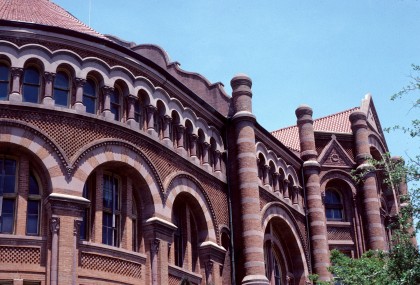Old Red, University of Texas Medical School Galveston

Nowhere was the rising affluence of Texas in the late nineteenth century more evident than in Galveston, dubbed at the time “Queen City of the Gulf.” All of the promise and prosperity of blossoming American capitalism were here, fed by a booming port that had become the gateway to the New West. Heady Galveston was ready to tear down its modest frame structures and rebuild in brick and stone to show its sister ports of Boston, New Orleans, and New York that this Texas lady had come of age.
When Nicholas J. Clayton arrived in Galveston in the winter of 1872, the city was embarking on this new surge. Irish by birth, but raised by his widowed mother in Cincinnati, Clayton came to the city to supervise construction of the showy new First Presbyterian Church designed by his employer – the Memphis architectural firm of Jones and Baldwin. Within a few years, he set up his own firm, becoming one of the first professional architects to establish a practice in Texas.
Over the next three decades Clayton’s work and influence would dominate the physical character of Galveston. During his career, he would be involved in almost two hundred building projects in Galveston alone, including at least twelve churches, six major public schools, the Post Office and Federal Building, the Santa Fe Union Depot, and numerous hotels, homes, banks, and business offices. On one street alone, The Strand (the heart of commercial Galveston), fifteen buildings are credited to Clayton.
Sadly, only fifty or so Clayton buildings remain in Galveston today. Some were destroyed in the great fire of November 1885 that wiped out forty-five blocks of the city. The flamboyant Beach Hotel burned to the ground in a similar heartbreaking conflagration while Clayton watched from his bed in 1898. But it was the disastrous hurricane of 1900 that took the greatest toll of Clayton buildings. The majestic Sacred Heart Church, completed only seven years earlier and touted as the largest church building in the Southwest, was so severely damaged that it had to be demolished. Much of Clayton’s other work, though very substantially built, was also severely damaged or destroyed.

The storm of 1900 broke the spirit of Galveston and forced it to retrench from its position as the leading commercial and business center in the state. At the turn of the century the storm, as well as personal financial reversals, also struck a blow to Clayton from which he never fully recovered. Although he continued to practice architecture in Galveston until his death in 1916, it is his work of the 1880s and 1890s for which he is most remembered.
One of Clayton’s largest and most prestigious commissions of that era was the design of a new building for the University of Texas Medical School in Galveston. The building resulting from this important commission is a muscular and wildly ornamented red brick and limestone structure, known over the years as “Old Red.” It is a parvenu pile of unrestrained invention, mixing Romanesque arcades with Spanish Baroque parapets, Italian Gothic gables, and vaguely Moorish pinnacles. Layered onto a robust massing and rendered in seemingly endless inventions of stone and brick patterning, the disparate styles are as compatible as the Greeks, Turks, Scandinavians, Germans, Spaniards, and Anglos who rubbed shoulders in Galveston bars at the time.
The eclectic combination of forms in “Old Red” was common in the late Victorian era. But the building is progressive for its time in the classical and orderly arrangement of its disparate parts. In a period with a strong predilection for picturesque massing, the building distinguishes itself with a bold, unflinching bilateral symmetry. Its flamboyant parts are disciplined by repetition, rhythm, and massive scale. The huge two-story arcade that wraps completely around the building and binds it together owes a probable debt to H. H. Richardson’s Cheney Block in Boston of 1875, although its use here is much more extensive.
The texturing of “Old Red” is truly remarkable. Galveston, as a port city, had collected a fine corps of masons and bricklayers who had immigrated from Western Europe. Clayton took full advantage of their skills here, requiring layer after layer of arches, corbels, brick dentils, and angled bond. The master brick mason on the job was Clayton’s favorite, Denny Devlin, who also laid the even more elaborate brickwork of the Ursuline Convent a few years later.
The interior of the building incorporated all of the most progressive features of medical institution design of the day, including skylighted dissection laboratories and large amphitheatres. But, alas, rapidly changing medical technology and facility requirements through the years have rendered many of its spaces obsolete today. Although it is still owned by the University of Texas Medical School, it has suffered years of disuse and neglect. Its surroundings have been altered radically as well, leaving little support for the grand old vestige which once lorded over its end of a booming island.